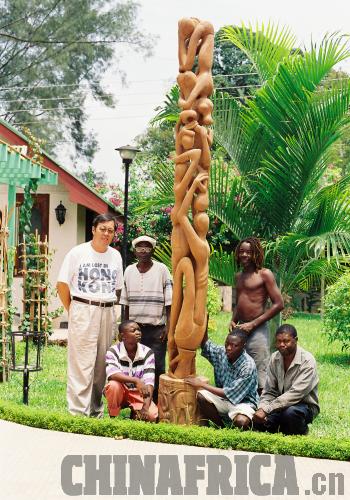|
 |
|
INTRICATE: Li Songshan and craftsmen with one of his Makonde woodcarvings in Tanzania |
The Makonde are an ethnic group living along the Tanzania-Mozambique border. They are considered some of Africa's most talented woodcarvers and their craftsmanship has been passed down from generation to generation. Makonde woodcarving is often referred to as the grandfather of modern African wood sculpture. Its exaggerated human and animal patterns reflect the essence of traditional African culture, full of imagination and inspired by nature.
Makonde carving depicts the group's fears and hopes, their spirituality and mysticism, religion and myths. Themes both traditional and modern make their way into the sculptures. They have been enthusiastically embraced in particular by one couple: Li Songshan and his wife Han Rong.
These days, the couple's apartment in Beijing looks like a treasure trove, full of delicate Makonde woodcarvings brought from Tanzania. But why are they so intrigued by the carvings?
A first glimpse
The couple's close relationship with Tanzania started in the 1960s when they began to study Swahili, a language widely spoken throughout East Africa in countries like Tanzania and Kenya.
After graduating from university, the Chinese Government sent Li and Han to Tanzania repeatedly. There, they worked as team members in economic aid groups, medical teams and art troupes.
In 1984, Li worked as an interpreter for a Makonde woodcarving exhibition in Beijing. It was the first showing of Tanzanian art in China. "These are not ordinary carvings," Liu Kaiqu, then one of the country's most eminent sculptors, told the couple at the exhibition. "It is one of the important art forms in the world."
From that point on, Li and his wife devoted themselves to collecting Makonde woodcarvings.
|